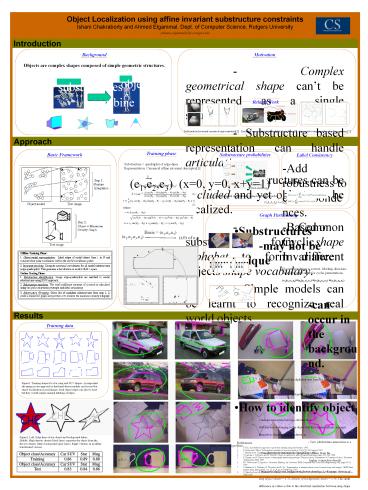Object Localization using affine invariant substructure constraints - PowerPoint PPT Presentation
1 / 1
Title:
Object Localization using affine invariant substructure constraints
Description:
Object Localization using affine invariant substructure constraints. Ishani ... Training shapes for star, mug and SUV shapes. An important ... – PowerPoint PPT presentation
Number of Views:39
Avg rating:3.0/5.0
Title: Object Localization using affine invariant substructure constraints
1
Object Localization using affine invariant
substructure constraints Ishani Chakraborty and
Ahmed Elgammal, Dept. of Computer Science,
Rutgers University ishanic,elgammal_at_cs.rutgers.e
du
Introduction
Background Objects are complex shapes composed
of simple geometric structures.
Motivation - Complex geometrical shape cant be
represented as a single structure. -
Substructure based representation can handle
articulation. - Substructures can be occluded
and yet object can be localized. - Common
substructures form shape alphabet to form
different objects shape vocabulary. - Simple
models can be learnt to recognize real world
objects.
object
substructures
Related Work
combine
Deformation Invariant canonical representation2
Keypoint representation on a global shape
basis.8
Connected-component based edge grouping.7
Approach
Training phase
Substructure probabilities
Basic Framework
Label Consistency
-Add robustness to correspondences. -Based on
Cyclic Invariance. If correspondence is
correct, labeling decisions should be equivalent
for cyclic permutations. (e1e2,e3,e4)(e4e1,e2
,e3) (e3e4,e1,e2) (e2e3,e4,e1)
Substructure quadruplet of edge-lines Representa
tion Canonical affine invariant descriptor1.
T
(e1,e2,e3) (x0, y0, xy1)
Find T and hence find T(e4)
Search model distributions using k-NN approach
w (I1,I2,I3,I4) ? (l1,l2,l3,l4)
Graph Partitioning
- Substructures -may not be unique
- -can occur in the background.
- Mug object coexists with the alphabets that
form the background clutter. - Alphabet structures U and G together are
similar to mug object. - How to identify object
- Consider interaction between substructures.
- Substructures belonging to the object will
have higher affinity amongst themselves than
background clutter. ie. - - View substructure interaction as a graph
partitioning problem. - Consider object
structure as comprising of lines from the - higher connection density.
- Comparing object and background cluster
densities. Left image density of mug object
cluster 1.76, density of background cluster
1.56. The small difference in values is due
to the structural similarities between mug shape
and the background (e.g. alphabet U, G
etc.). Right image density of mug object
cluster 2.37, density of background cluster
0.06 - the object forms a much denser
cluster than the background. Graph partitioning
using metis5.
Basis (e1,e2,e3)
(e1,e2,e3,e4)
(r,?) of e4
Results
Training data
Figure1. Training shapes for star, mug and SUV
shapes. An important advantage in our approach
is that hand-drawn models can be used for object
localization in real images. Real object edges
can also be used but they would require manual
labeling of edges.
Figure2. Left Edge lines of star object and
background letters. . Middle High density
cluster (black lines) separates the object from
the the low density letters background (grey
lines). Right Clusters in an affine transformed
version.
- References
- F. Tsai. A probabilistic approach to geometric
hashing using line features. 1993. - E. Rivlin and I.Weiss. Deformation invariants in
object recognition. 65(1)95108, January 1997. - J. Mundy and A. Zisserman. Geometric Invariance
in Computer Vision. MIT Press, 1992. - Y. Lamdan, J. Schwartz, and H. Wolfson. Object
recognition by affine invariant matching. pages
335344, 1988. - E. Karypis and V. Kumar. hmetis A hypergraph
partitioning package. Technical report,
Department of Computer Science, University of
Minnesota, MN, 1998. - H.J. Wolfson and I. Rigoutsos. Geometric Hashing
An Overview. IEEE Computational Science and
Engineering, 4(4), pages10-21, 1997. - S. Mahamud, L. Williams, K. Thornber, and K. Xu,
Segmentation of multiple salient closed contours
from real images, IEEE Trans. Pattern Anal.
Mach. Intell., vol. 25, no. 4, pp. 433444, Apr.
2003. - I.Chakraborty and A. Elgammal, Combining Low and
High Level Features for Object Recognition,
Accepted for Oral Presentation, ICPR 2006.































